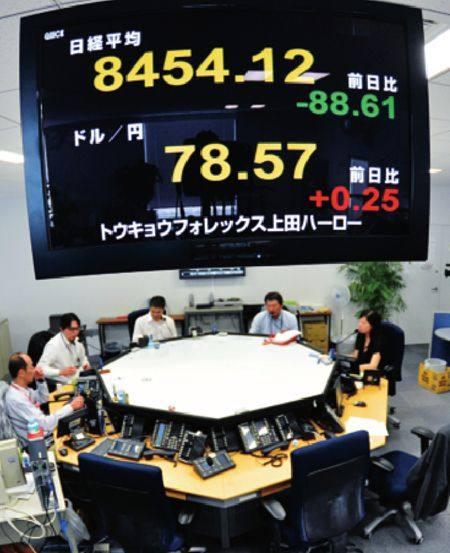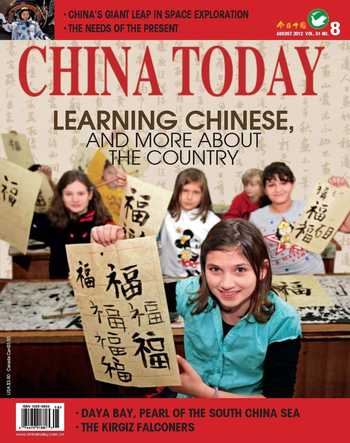Steady Progress in RMB Internationalization
JIAO FENG

ON April 18, 2012, HSBC Hold- ings PLC issued the first RMBdenominated bond in London. Marketed to investors in Britain and Continental Europe, the bond issuance is expected to eventually raise more than RMB 1 billion.
On the same day, the official launch of the City of London as an international center for RMB business took place, and a report entitled “London: a Center for RMB Business” was released. British Chancellor of the Exchequer George Osborne attended the ceremony, and said the launch of the program would further promote the development of RMB products and services on the London market and increase the Chinese currencys cross-border use.
London has now become the second offshore Yuan center after Hong Kong. Analysts believe this heralds the start of a big expansion of RMB business in Europe, and eventually the globe.
Growing needs
Since joining the World Trade Organization (WTO), China has steadfastly pursued its opening-up strategy and has benefited from smooth and rapid development in its foreign trade. With authorization from the State Council, the crossborder trade settlement in RMB pilot program, which originally ran in Shanghai and four cities in Guangdong Province, has been instituted nationwide. Its scope has been expanded to encompass both current and capital account trade. Now, RMB can be used to settle accounts dealing with both outward foreign direct investment (OFDI) and inward foreign direct investment (FDI)
There are a number of benefits for overseas enterprises in using RMB to settle accounts. RMB settlement re- duces “shoestring costs,” i.e. the cost of exchanging currency. With this comes lower exposure to exchange rate fluctuations and a quicker payment process. For countries and regions that conduct RMB settlements, it is now easier to attract FDI from China and more convenient for their enterprises to funnel direct investment into the country.
According to data from the Peoples Bank of China, Chinas central bank, the total cross-border settlement in RMB in 2011 amounted to RMB 2.08 trillion, an increase of 3.1 times over 2010. In the first quarter of this year, the figure reached RMB 580.4 billion, representing a yearly increase of 61 percent.
RMB acceptance and exchange is widespread in Taiwan, Hong Kong and Macao. In Southeast Asia RMB has become one of the main currencies in wide circulation alongside the U.S. dollar, Euro and Yen. RMB is also commonly exchanged and circulated in the five Central Asian “Stans”– Uzbekistan, Turkmenistan, Kazakhstan, Kyrgyzstan and Tajikistan, as well as in Russia, Pakistan and Mongolia. To satisfy the needs of Chinese visitors, increasing numbers of airports and hotels in the U.S., Canada and many European countries are also providing RMB exchange services.
The volume of overseas bank deposits in RMB continues to rise. According to London: a Center for Renminbi Business, by the end of 2011 the total amount of London customer, institutional and interbank RMB deposits was in excess of RMB 109 billion. Customer deposits– deposits in accounts for personal and corporate customers – amounted to RMB 35 billion. Cities like Singapore and Tokyo are reported to be considering setting up offshore yuan centers.
“In current cross-border trade settlements, use of RMB as settlement currency does not mean it has become the money of account – the currency actually in the bank. The U.S. dollar and other reserve currencies still dominate where money of account is concerned,” said Yin Jianfeng, deputy director of the Institute of Finance& Banking of Chinese Academy of Social Sciences. “There remains a huge gap between use of the Yuan and the international currency staples such as U.S. dollar and Euro.”
Quality Assets
Basically speaking, the international markets acceptance of a currency is based on confidence in the issuing countrys economic fortunes and the stability of its financial system.
In recent years, the world has borne witness to Chinas stable economic growth. Since the launching of exchange rate reform in 2005, the yuan-dollar exchange rate has maintained an appreciating trend, and this appreciation is expected to steadily continue. A stable exchange rate and a low inflation rate are lending steam to the promotion of international settlements in RMB.
The global financial crisis and the European sovereign debt crisis have caused large fluctuations and depreciations in major reserve currencies. This has accelerated the devaluation of fixed assets and increased exchange rate risk. The European sovereign debt crisis, which continues to deepen, has raised demand in financial hedging devices and safe-haven assets.
The Euro and U.S. dollar face crises of confidence due to woeful economic performances in those currency areas, and investors have been seeking a new safehaven currency. In this context, RMB has been recognized as a high-quality and stable asset.
Some economists believe it possible to form a diversified settlement system employing the U.S. dollar, Euro and Yuan in unison. The current financial crisis may also accelerate the formation of a regional currency in Asia, and RMB stands in good stead to fill this role, at least in Southeast Asia to begin with.
According to Yin Jianfeng, the internationalization of RMB not only fulfills the need to reconstruct the international monetary system along more representative lines, but also represents a necessary step for the Chinese mainland to shore up the value of its financial assets.
As the current international monetary system supported by the dollar and the Euro has encountered serious problems, a three-pillar system is billed as a move toward greater stability.
Liquidity Is the Key
Ensuring greater RMB liquidity is key to determining its internationalization. The Yuan can only become a true world currency if it is widely used and freely convertible in international trade settlements and financial markets.
In order to transform the Yuan into a money of account in international financial markets, the currency requires a mature and efficient financial market as its carrier. This not only demands a developed and open domestic RMB market, but also asks for extensive offshore RMB markets, and whats more, clear, two-way circulation channels between them.
By the end of 2010 in China, of the 40 specific items classified under capital ac- count transactions by the IMF, five items had been fully opened, eight made basically convertible, 17 partially opened and the remaining 10 kept tightly restricted. Restrictions apply to sectors such as crossborder investments in securities, trade of derivatives and short-term foreign debt. It is expected that tightly restricted items will be loosened gradually as China continues its sweeping financial reforms.
According to Yin, the development of the onshore RMB market should precede that of the offshore market. There is no key reserve currency whose formation has depended on offshore markets. Only once its onshore market has been fully developed can the country loosen regulations on capital account items and form effective circulation channels between onshore and offshore markets.
On April 16, the Peoples Bank of China widened RMBs trading band against the U.S. dollar to +/- one percent in any given day, up from 0.5 percent. This aims to enhance the two-way floatability of the RMB exchange rate and give greater freedom to market forces.
A greater role for market determination of the RMB exchange rate is conducive to gradually promoting RMB convertibility under capital account. Sources have revealed that the Peoples Bank of China will also relax in timely fashion policies on personal RMB business; this should further facilitate cross-border RMB transactions.
Lessons to Learn
Before the U.S. dollar and the Euro became offshore currencies, they were already freely convertible currencies, hence avoiding the need for settlement centers. Currently, as RMB is not freely convertible, overseas settlement centers are still necessary to help Chinas central bank monitor capital movements and manage risk. The RMBs route to internationalization looks different from the U.S. dollar and the Euro, with “trade settlements plus offshore markets and capital account liberalization” being the chosen route. This is similar to the route taken by the Yen as it was internationalized.
According to Yin, the Yen emerged as an international currency in the 1990s, but this came at painful costs – the rapid appreciation of its currency worsened the effects of a bursting Japanese real estate bubble and subsequent recession, and is partly to blame for the countrys prolonged economic stagnation. The Yens share in the basket of international reserve currencies actually dropped from 6.78 percent in 1995 to 3.01 percent in 2009, far below the dollar (62.17 percent) and the Euro (27.3 percent).
The Yen is also far behind the U.S. dollar and the Euro as a settlement currency in economic and financial transactions. Now, the Yens main function is in unproductive currency carry trades, whereby investors profit from the discrepancy between the Bank of Japans low key interest rate and other countries higher rates. The Yens internationalization has become a failure.
“This failure carries important lessons for us. Japan hurriedly opened its capital accounts before fully implementing domestic financial reform,” said Yin Jianfeng. “Before the doors are flung open, the house needs to be in order; lagging domestic financial reform and poor enterprise performance in international manufacturing and trading chains dont cut it in the world of free-flowing capital.”
A Long Way to Go
According to Ba Shusong, deputy director-general of the Financial Research Institute at the State Councils Development Research Center, the huge fluctuations in major reserve currencies caused by the international financial crisis and the growing demand for RMB in neighboring markets are the main driving forces promoting RMB internationalization.
The Chinese government has not set a clear timetable for RMB internationalization, and this signifies policymakers pragmatic approach to the issue. The steady progress being made is in line with, not ahead of, economic growth and market demand realities.
Today, over 180 countries and regions engage in cross-border RMB settlement business with China. By the end of January 2012, the Peoples Bank of China had signed currency swap agreements with 15 foreign central banks and monetary authorities, with a total volume of RMB 1.3362 trillion. As the offshore RMB market in Hong Kong has matured, RMB deposits have come to represent about 10 percent of the total bank deposits in the special administrative region. The Yuan has become the third most commonly exchanged currency in Hong Kong after the HK dollar and the U.S. dollar.
A market-oriented exchange rate system for the Yuan with foreign currencies has also been established. Last June, China and Japan started direct interbank trading of their currencies. Several other national central banks announced the decision to bring the Yuan into their baskets of foreign exchange reserves. This signifies that RMB is on its way to true regionalization.
The goal of RMB internationalization is for the currency to become an important global reserve currency, the essential functions of which are to be storage of value and a money of account. In this respect, despite progress having been made in cross-border settlements, there is a long way to go until the Yuan becomes a truly international currency. Moreover, judging by Chinas high saving rate and the twin surplus in both its current and capital accounts, the question of how to promote Chinese capital exports via the internationalization of RMB is yet to be resolved.

